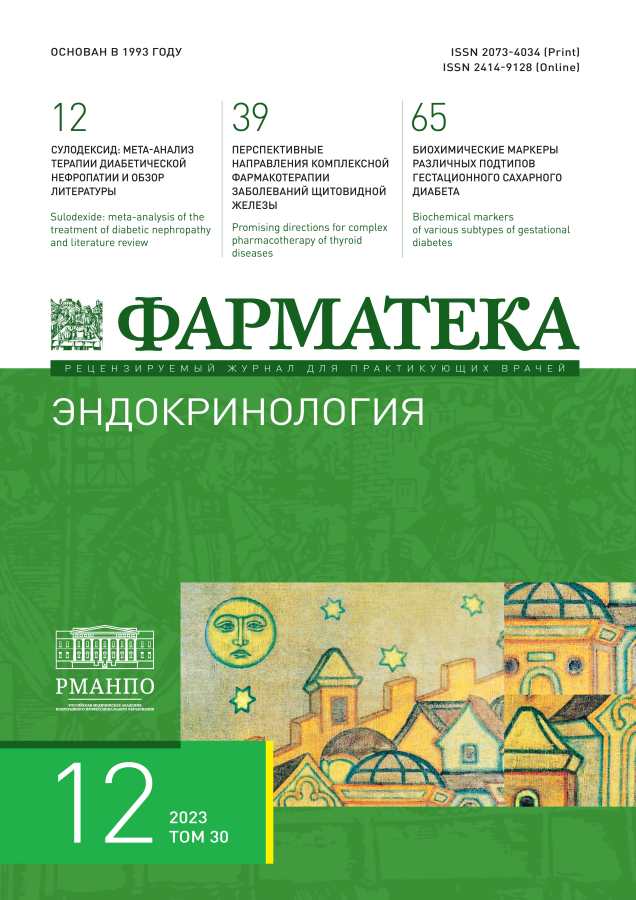Modern possibilities for assessing glycemia in diabetic patients
- Autores: Chernikova N.A.1, Degtyareva E.I.2
-
Afiliações:
- Russian Medical Academy of Continuous Professional Education
- Central Clinical Hospital of Civil Aviation
- Edição: Volume 30, Nº 12 (2023)
- Páginas: 58-64
- Seção: New drugs and treatment approaches
- URL: https://journals.eco-vector.com/2073-4034/article/view/626038
- DOI: https://doi.org/10.18565/pharmateca.2023.12.58-64
- ID: 626038
Citar
Texto integral
Resumo
Diabetes mellitus (DM) is one of the most common chronic diseases that require constant monitoring of glycemic levels. In recent years; modern methods for assessing glycemia which significantly improve the quality of life of patients and facilitate the management of their disease have been developed and implemented. Glycemic self-monitoring (GSM) is an integral part of diabetes management and is essential for achieving optimal blood glucose control. Modern self-monitoring techniques; such as the use of advanced glucose meters; allow patients to quickly and accurately measure their blood glucose levels; which helps them make informed decisions about next steps in managing their disease. GSM also allows patients to track the effectiveness of their treatment and identify factors that may affect blood glucose levels; such as diet; physical activity and stress. GSM allows patients to prevent possible complications associated with low or high blood glucose. The use of 24-hour glucose data is an important tool for effective diabetes management. This data can help patients identify glucose peaks and valleys; as well as identify patterns that may be related to certain factors such as diet; physical activity and stress. Using this data; patients can make more informed decisions about their treatment. Overall; the use of 24-hour glucose data allows patients to more accurately monitor their disease; make individualized treatment decisions; and effectively manage diabetes.
Texto integral
Sobre autores
Natalya Chernikova
Russian Medical Academy of Continuous Professional Education
Autor responsável pela correspondência
Email: nachendoc@yandex.ru
Cand. Sci. (Med.), Associate Professor
Rússia, MoscowE. Degtyareva
Central Clinical Hospital of Civil Aviation
Email: nachendoc@yandex.ru
Rússia, Moscow
Bibliografia
- Атлас IDF по диабету; 10-е издание; 2021 г. [IDF Diabetes Atlas 10th edition 2021. (In Russ.)]. URL: https://diabetesatlas.org/
- Introduction and Methodology: Standards of Care in Diabetes-2023. Diab Care. 2022;46(suppl 1):S1–S4. doi: 10.2337/dc23-Sint.
- Machry R.V.; Rados D.V.; Gregorio G.R.; Rodrigues T.C. Self-monitoring blood glucose improves glycemic control in type 2 diabetes without intensive treatment: A systematic review and meta-analysis. Diab Res Clin Pract. 2018;142:173–87. doi: 10.1016/j.diabres.2018.05.037.
- Self-monitoring of Blood Glucose (SMBG): From Theory to Clinical Practice – Thomas Danne; MD Faculty and Disclosures. URL: https://www.medscape.org/viewarticle/709187.
- Zou; Yue Zhao; Sixuan& Li; et al. The Efficacy and Frequency of Self-monitoring of Blood Glucose in Non-insulin-Treated T2D Patients: a Systematic Review and Meta-analysis. J General Inter. Med. 2022;38. doi: 10.1007/s11606-022-07864-z.
- Xu Y.; Tan D.H.Y.; Lee J.Y. Evaluating the impact of self-monitoring of blood glucose frequencies on glucose control in patients with type 2 Diabetes who do not use insulin: a systematic review and meta-analysis. Int J Clin Pract. 2019;73(7):e13357. doi: 10.1111/ijcp.13357.
- Mohan V.; Ravikumar R.; Poongothai S.; et al. A single-center; open; comparative study of the effect of using self-monitoring of blood glucose to guide therapy on preclinical atherosclerotic markers in Type 2 Diabetic subjects. J Diab Sci Technol. 2010;4(4):942–48. doi: 10.1177/193229681000400425.
- Sieber J.; Flacke F.; Link M.; et al. Improved Glycemic Control in a Patient Group Performing 7-Point Profile Self-Monitoring of Blood Glucose and Intensive Data Documentation: An Open-Label; Multicenter; Observational Study. Diab Ther. 2017;8(5):1079–85. doi: 10.1007/s13300-017-0306-z.
- Bergenstal R.M.; Mullen D.M.; Strock E.; et al. Randomized comparison of self-monitored blood glucose (СГ) versus continuous glucose monitoring (НМГ) data to optimize glucose control in type 2 diabetes. J Diab Complicat. 2022;36(3):108106. doi: 10.1016/j.jdiacomp.2021.108106.
- Parkin C.G.; Davidson J.A. Value of self-monitoring blood glucose pattern analysis in improving diabetes outcomes. J Diab Sci Technol. 2009;3(3):500–8. doi: 10.1177/193229680900300314.
- Vigersky R.A.; McMahon C. The Relationship of Hemoglobin A1C to Time-in-Range in Patients with Diabetes. Diab Technol Ther. 2019;21(2):81-85. doi: 10.1089/dia.2018.0310.
- Yapanis M.; James S.; Craig M.E.; et al. Complications of Diabetes and Metrics of Glycemic Management Derived From Continuous Glucose Monitoring. J Clin Endocrinol Metab. 2022;107(6):e2221–36. doi: 10.1210/clinem/dgac034.
- Farmer AJ; Perera R; Ward A; et al. Meta-analysis of individual patient data in randomised trials of self monitoring of blood glucose in people with non-insulin treated Type 2 Diabetes. BMJ. 2012;344:e486. https://doi.org/10.1136/ bmj.e486
- UK Prospective Diabetes Study Group. UK prospective diabetes study (UKPDS). Diabetologia. 1991;34:877–89. doi: 10.1007/BF00400195
- Holman R.R.; Paul S.K.; Bethel M.A.; Matthews D.R.; Neil H.A. 10-Year follow-up of intensive glucose control in Type 2 Diabetes. N Engl J Med. 2008;359(15):1577–89 doi: 10.1056/NEJMoa0806470.
- American Diabetes Association https://professional.diabetes.org/
- Bergenstal R.M.; Beck R.W.; Close K.L.; et al. Glucose Management Indicator (GMI): A New Term for Estimating A1C From Continuous Glucose Monitoring. Diabetes Care. 2018;41(11):2275-80. doi: 10.2337/dc18-1581.
Arquivos suplementares














